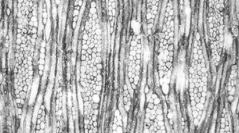

 Comptes Rendus Palevol
6 (6-7) - Pages 393-401
Comptes Rendus Palevol
6 (6-7) - Pages 393-401The genus Eristophyton is founded on woody axes of Mississippian age, showing a dense wood with an araucarioid type of pitting on the radial walls of tracheids and small numerous pits in cross-fields. Distinctive characters of Eristophyton are related to its primary vascular body, especially the structure and arrangement of primary xylem strands, and structure and size of leaf traces. Species described from Permian deposits are not considered in this review, which focuses on the three Mississippian species, E. beinertianum, E. fasciculare, and E. waltonii. Eristophyton consist of plants of arborescent stature that produced a large amount of vascular and cortical secondary tissues, and had their leaves borne on the youngest axes. Anatomical and morphological similarities with Bilignea and Pitus are emphasized. Compared to all other arborescent genera of lignophytic affinities known for the Mississippian, Eristophyton has the widest geographical and stratigraphical extent.
Lignophytes, trees, Mississippian, Europe, anatomy